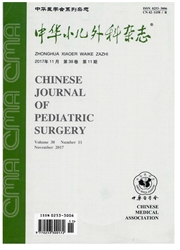

 中文摘要:
中文摘要:
目的研究BMP-2在髋臼软骨发育早期及发育不良髋臼软骨可逆性恢复过程中的作用。方法通过伸髋内收、模拟襁褓体位固定新生大鼠双后肢,建立发育不良髋臼软骨模型。将髋臼标本经HE染色后观察比较正常及发育不良髋臼软骨组织形态学变化特点,同时用ELISA方法和PCR方法分别检测BMP-2、BMP-4、BMP-6、BMP-7的分泌及基因表达情况。将捆绑不同时间后的大鼠松绑,其中部分当场处死,其余大鼠继续喂养,最终至30日龄,建立发育不良髋臼软骨可逆性恢复模型。研究其髋臼软骨组织形态学恢复及BMP-2分泌变化情况。结果正常大鼠髋臼软骨呈半圆形、容积大、表面光滑。发育不良髋臼软骨髋臼上缘肥厚,软骨发生变性,与周围组织分界不清。髋臼软骨BMP-2的分泌在正常大鼠7日龄和9日龄时出现高峰,分别为(13.7±0.29)ng/ml和(13.9±0.38)ng/ml。而在发育不良髋臼软骨中这一分泌高峰消失。在发育不良髋臼软骨可逆性恢复组,捆绑4d和6d的大鼠,BMP-2的分泌高峰出现延迟,都在15日龄时出现;而在捆绑8d及以上的大鼠,在松绑后继续喂养至30日龄,髋臼软骨组织形态无法恢复正常,并且BMP-2的分泌高峰未出现。结论BMP-2的分泌可能是髋臼软骨早期发育情况的生物学标记之一。
 英文摘要:
英文摘要:
Objective To explore the early-stage acetabulum development in normal and dysplastic acetabula and elucidate the function of bone morphogenetic protein 2 (BMP-2) in early acetabulum development and dysplastic acetabulum remodeling. Methods The rat model of dysplastic acetabulum was established by maintaining hips in a swaddling position. By analyzing the cartilage histologic characteristics, early-stage acetabulum developments were examined in normal and dysplastic acetabulum animals. Meantime, the mRNA expression and chondrocyte secretion of functional BMP-2, bone morphogenetic protein 4 (BMP-4), bone morphogenetic protein 6 (BMP-6) and bone morphogenetic protein 7 (BMP-7) were detected at different postnatal timepoints using realtime fluorescence quantitative polymerase chain reaction and enzyme-linked immunosorbent assay respectively. Then the cartilage morphologic remodeling was observed in banding removal group. The mRNA expression and chondrocytic secretion of functional BMP-2 were detected in chondrocytes of each acetabulum. Results Normal acetabulum was semispheric with a large volume and a smooth surface while dysplastie acetabulum had a thickened superior border with degenerated cartilage. In normal rats, two secretion peaks of (13.7±0. 29) and (13.9 ± 0. 38) ng/ml occurred at Days 7 and 9. And the difference was statistically significant. In dysplastic acetabulum group, this peak disappeared. As for banding removal group, acetabulum developed almost normally at Day 30 after released banding at Days 2, 4 and 6. But for acetabula of rats released at Days 8 and 10, histomorphology indicated dysplastic acetabula. For acetabula in banding release group, the secretion peaks of BMP-2 in acetabula released at Days 2, 4 and 6 appeared later than normal. For acetabula released at Day 8 and later, the secretion peak of BMP-2 disappeared. Conclusions The secretion peak of BMP-2 may accelerate the early development of acetabula so that it is possibly a biomarker of acetabulum development.
 同期刊论文项目
同期刊论文项目
 同项目期刊论文
同项目期刊论文
 期刊信息
期刊信息
